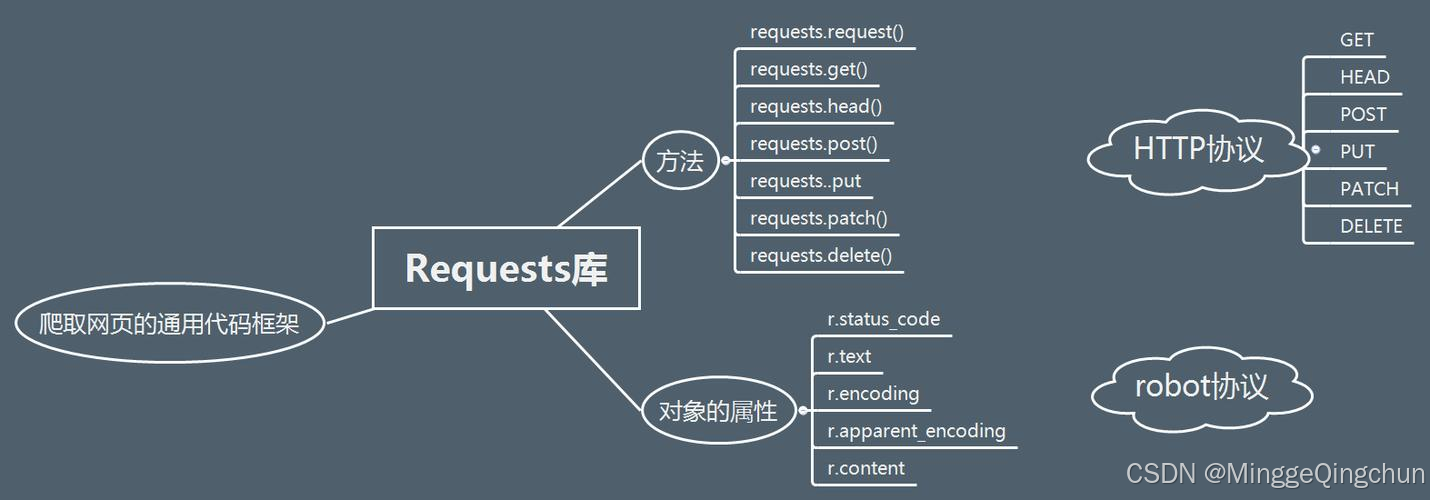requests库是一个功能强大的HTTP库,用于发送各种HTTP请求,如GET、POST、PUT、DELETE等。
requests官网:Requests: HTTP for Humans™ --- Requests 2.32.3 documentation
使用requests可以模拟浏览器的请求,比起之前用的urllib,requests模块的api更加便捷(本质就是封装了urllib3)
requests库可以通过pip安装:
python
pip install requests主要功能和特性
- API简洁:requests的API设计非常简洁,使得发送请求和获取响应变得非常容易。
- 支持多种请求方法:支持GET、POST、PUT、DELETE等多种HTTP请求方法。
- 会话管理:支持会话管理,可以保持连接,方便进行多次请求。
- 支持Cookies和Session:可以方便地处理Cookies和会话,实现模拟登录等功能。
- 异常处理:提供异常处理机制,方便处理网络请求中的错误。
- 支持自动编码:自动处理URL编码和响应内容的编码,使得使用更加方便。
- 支持代理和认证:可以设置代理服务器,支持HTTP认证。
- 响应内容处理:提供丰富的响应内容处理功能,如获取文本、二进制内容、JSON等。
高级功能和使用技巧
- 设置超时 :可以通过设置
timeout参数来控制请求的超时时间。 - 使用代理 :通过
proxies参数设置代理服务器。 - 自定义Headers :通过
headers参数可以自定义请求头,模拟浏览器请求。 - 处理JSON数据 :使用
json参数可以直接发送JSON数据,并自动处理响应的JSON数据。 - 异常处理 :使用try-except结构捕获并处理可能出现的异常,如
requests.exceptions.RequestException。 - 使用Cookies :通过
cookies参数可以设置或获取Cookies,实现会话管理

requests库7个主要方法
| 方法 | 说明 |
|---|---|
| requsts.requst() | 构造一个请求,最基本的方法,是下面方法的支撑 |
| requsts.get() | 获取网页,对应HTTP中的GET方法 |
| requsts.post() | 向网页提交信息,对应HTTP中的POST方法 |
| requsts.head() | 获取html网页的头信息,对应HTTP中的HEAD方法 |
| requsts.put() | 向html提交put方法,对应HTTP中的PUT方法 |
| requsts.patch() | 向html网页提交局部请求修改的的请求,对应HTTP中的PATCH方法 |
| requsts.delete() | 向html提交删除请求,对应HTTP中的DELETE方法 |
requests内置的状态字符
python
# -*- coding: utf-8 -*-
from .structures import LookupDict
_codes = {
# Informational.
100: ('continue',),
101: ('switching_protocols',),
102: ('processing',),
103: ('checkpoint',),
122: ('uri_too_long', 'request_uri_too_long'),
200: ('ok', 'okay', 'all_ok', 'all_okay', 'all_good', '\\o/', ''),
201: ('created',),
202: ('accepted',),
203: ('non_authoritative_info', 'non_authoritative_information'),
204: ('no_content',),
205: ('reset_content', 'reset'),
206: ('partial_content', 'partial'),
207: ('multi_status', 'multiple_status', 'multi_stati', 'multiple_stati'),
208: ('already_reported',),
226: ('im_used',),
# Redirection.
300: ('multiple_choices',),
301: ('moved_permanently', 'moved', '\\o-'),
302: ('found',),
303: ('see_other', 'other'),
304: ('not_modified',),
305: ('use_proxy',),
306: ('switch_proxy',),
307: ('temporary_redirect', 'temporary_moved', 'temporary'),
308: ('permanent_redirect',
'resume_incomplete', 'resume',), # These 2 to be removed in 3.0
# Client Error.
400: ('bad_request', 'bad'),
401: ('unauthorized',),
402: ('payment_required', 'payment'),
403: ('forbidden',),
404: ('not_found', '-o-'),
405: ('method_not_allowed', 'not_allowed'),
406: ('not_acceptable',),
407: ('proxy_authentication_required', 'proxy_auth', 'proxy_authentication'),
408: ('request_timeout', 'timeout'),
409: ('conflict',),
410: ('gone',),
411: ('length_required',),
412: ('precondition_failed', 'precondition'),
413: ('request_entity_too_large',),
414: ('request_uri_too_large',),
415: ('unsupported_media_type', 'unsupported_media', 'media_type'),
416: ('requested_range_not_satisfiable', 'requested_range', 'range_not_satisfiable'),
417: ('expectation_failed',),
418: ('im_a_teapot', 'teapot', 'i_am_a_teapot'),
421: ('misdirected_request',),
422: ('unprocessable_entity', 'unprocessable'),
423: ('locked',),
424: ('failed_dependency', 'dependency'),
425: ('unordered_collection', 'unordered'),
426: ('upgrade_required', 'upgrade'),
428: ('precondition_required', 'precondition'),
429: ('too_many_requests', 'too_many'),
431: ('header_fields_too_large', 'fields_too_large'),
444: ('no_response', 'none'),
449: ('retry_with', 'retry'),
450: ('blocked_by_windows_parental_controls', 'parental_controls'),
451: ('unavailable_for_legal_reasons', 'legal_reasons'),
499: ('client_closed_request',),
# Server Error.
500: ('internal_server_error', 'server_error', '/o\\', ''),
501: ('not_implemented',),
502: ('bad_gateway',),
503: ('service_unavailable', 'unavailable'),
504: ('gateway_timeout',),
505: ('http_version_not_supported', 'http_version'),
506: ('variant_also_negotiates',),
507: ('insufficient_storage',),
509: ('bandwidth_limit_exceeded', 'bandwidth'),
510: ('not_extended',),
511: ('network_authentication_required', 'network_auth', 'network_authentication'),
}
codes = LookupDict(name='status_codes')
for code, titles in _codes.items():
for title in titles:
setattr(codes, title, code)
if not title.startswith('\\'):
setattr(codes, title.upper(), code)json和data的区别:
使用json
当请求参数是JSON的时候使用json的参数当请求参数是json,但是要使用data的参数,那么请求参数要进行序列化的处理
使用data
当请求参数是表单的时候使用data当请求参数是JSON格式的时候,那么请求参数要进行序列化的处理
requests库的异常
| 异常 | 说明 |
|---|---|
| requests.ConnectionError | 网络连接异常,如DNS查询失败,拒绝连接等 |
| requests.HTTPError | HTTP错误异常 |
| requests.URLRequired | URL缺失异常 |
| requests.TooManyRedirects | 超过最大重定向次数,产生重定向异常 |
| requests.ConnectTimeout | 连接远程服务器超时异常 |
| requests.Timeout | 请求URL超时,产生超时异常 |
一、基于requests之GET请求
1、基本请求
python
# GET请求
r = requests.get('http://httpbin.org/get')
print(r.status_code,r.reason) # 200 OK
print(r.text)
# {
# "args": {},
# "headers": {
# "Accept": "*/*",
# "Accept-Encoding": "gzip, deflate",
# "Host": "httpbin.org",
# "User-Agent": "python-requests/2.32.3",
# "X-Amzn-Trace-Id": "Root=1-67a700f6-138938e6136cffb223f72ef3"
# },
# "origin": "58.241.18.10",
# "url": "http://httpbin.org/get"
# }2、带参数的GET请求->params
python
# GET带参数请求
r = requests.get('http://httpbin.org/get',params={'name':'zhangsan','age':18})
print(r.json()) # {'args': {'age': '18', 'name': 'zhangsan'}, 'headers': {'Accept': '*/*', 'Accept-Encoding': 'gzip, deflate', 'Host': 'httpbin.org', 'User-Agent': 'python-requests/2.32.3', 'X-Amzn-Trace-Id': 'Root=1-67a700f7-7cf1df80781d94dd57a99d44'}, 'origin': '58.241.18.10', 'url': 'http://httpbin.org/get?name=zhangsan&age=18'}3、带参数的GET请求->headers
通常我们在发送请求时都需要带上请求头,请求头是将自身伪装成浏览器的关键,常见的有用的请求头如下
python
ua = 'Mozilla/5.0 (Windows NT 10.0; Win64; x64) AppleWebKit/537.36 (KHTML, like Gecko) Chrome/111.0.0.0 Safari/537.36 Edg/111.0.1661.62'
headers = {
'User-Agent':ua
}
r = requests.get('http://httpbin.org/headers',headers=headers)
print(r.json()) # {'headers': {'Accept': '*/*', 'Accept-Encoding': 'gzip, deflate', 'Host': 'httpbin.org', 'User-Agent': 'Mozilla/5.0 (Windows NT 10.0; Win64; x64) AppleWebKit/537.36 (KHTML, like Gecko) Chrome/111.0.0.0 Safari/537.36 Edg/111.0.1661.62', 'X-Amzn-Trace-Id': 'Root=1-67a70344-0928ab01777e0ca91dd4e6db'}}4、带参数的GET请求->cookies
登录github,然后从浏览器中获取cookies,以后就可以直接拿着cookie登录了,无需输入用户名密码
python
cookies = dict(userid='111111', token='abcd1234')
r = requests.get('http://httpbin.org/cookies',cookies=cookies)
print(r.json()) # {'cookies': {'token': 'abcd1234', 'userid': '111111'}}二、基于POST请求
python
r = requests.post('http://httpbin.org/post',data={'name':'zhangsan','age':18})
print(r.json()) # {'args': {}, 'data': '', 'files': {}, 'form': {'age': '18', 'name': 'zhangsan'}, 'headers': {'Accept': '*/*', 'Accept-Encoding': 'gzip, deflate', 'Content-Length': '20', 'Content-Type': 'application/x-www-form-urlencoded', 'Host': 'httpbin.org', 'User-Agent': 'python-requests/2.32.3', 'X-Amzn-Trace-Id': 'Root=1-67a702b9-7bc957120cdadae371c32908'}, 'json': None, 'origin': '58.241.18.10', 'url': 'http://httpbin.org/post'}1、GET请求
HTTP默认的请求方法就是GET
1、没有请求体
2、数据必须在1K之内
3、GET请求数据会暴露在浏览器的地址栏中
GET请求常用的操作:
1、在浏览器的地址栏中直接给出URL,那么就一定是GET请求
2、点击页面上的超链接也一定是GET请求
3、提交表单时,表单默认使用GET请求,但可以设置为POST
2、POST请求
1、数据不会出现在地址栏中
2、数据的大小没有上限
3、有请求体
4、请求体中如果存在中文,会使用URL编码!
注:
!!!requests.post()用法与requests.get()完全一致,特殊的是requests.post()有一个data参数,用来存放请求体数据
python
import requests
'''
requests使用
'''
print('--------GET请求--------')
# GET请求
r = requests.get('http://httpbin.org/get')
print(r.status_code,r.reason) # 200 OK
print(r.text)
# {
# "args": {},
# "headers": {
# "Accept": "*/*",
# "Accept-Encoding": "gzip, deflate",
# "Host": "httpbin.org",
# "User-Agent": "python-requests/2.32.3",
# "X-Amzn-Trace-Id": "Root=1-67a700f6-138938e6136cffb223f72ef3"
# },
# "origin": "58.241.18.10",
# "url": "http://httpbin.org/get"
# }
# GET带参数请求
r = requests.get('http://httpbin.org/get',params={'name':'zhangsan','age':18})
print(r.json()) # {'args': {'age': '18', 'name': 'zhangsan'}, 'headers': {'Accept': '*/*', 'Accept-Encoding': 'gzip, deflate', 'Host': 'httpbin.org', 'User-Agent': 'python-requests/2.32.3', 'X-Amzn-Trace-Id': 'Root=1-67a700f7-7cf1df80781d94dd57a99d44'}, 'origin': '58.241.18.10', 'url': 'http://httpbin.org/get?name=zhangsan&age=18'}
print('--------POST请求--------')
r = requests.post('http://httpbin.org/post',data={'name':'zhangsan','age':18})
print(r.json()) # {'args': {}, 'data': '', 'files': {}, 'form': {'age': '18', 'name': 'zhangsan'}, 'headers': {'Accept': '*/*', 'Accept-Encoding': 'gzip, deflate', 'Content-Length': '20', 'Content-Type': 'application/x-www-form-urlencoded', 'Host': 'httpbin.org', 'User-Agent': 'python-requests/2.32.3', 'X-Amzn-Trace-Id': 'Root=1-67a702b9-7bc957120cdadae371c32908'}, 'json': None, 'origin': '58.241.18.10', 'url': 'http://httpbin.org/post'}
print('--------自定义headers请求--------')
ua = 'Mozilla/5.0 (Windows NT 10.0; Win64; x64) AppleWebKit/537.36 (KHTML, like Gecko) Chrome/111.0.0.0 Safari/537.36 Edg/111.0.1661.62'
headers = {
'User-Agent':ua
}
r = requests.get('http://httpbin.org/headers',headers=headers)
print(r.json()) # {'headers': {'Accept': '*/*', 'Accept-Encoding': 'gzip, deflate', 'Host': 'httpbin.org', 'User-Agent': 'Mozilla/5.0 (Windows NT 10.0; Win64; x64) AppleWebKit/537.36 (KHTML, like Gecko) Chrome/111.0.0.0 Safari/537.36 Edg/111.0.1661.62', 'X-Amzn-Trace-Id': 'Root=1-67a70344-0928ab01777e0ca91dd4e6db'}}
print('--------带cookies请求--------')
cookies = dict(userid='111111', token='abcd1234')
r = requests.get('http://httpbin.org/cookies',cookies=cookies)
print(r.json()) # {'cookies': {'token': 'abcd1234', 'userid': '111111'}}
print('--------Basic-auth认证请求--------')
r = requests.get('http://httpbin.org/basic-auth/admin/admin123',auth=('admin','admin123'))
print(r.json()) # {'authenticated': True, 'user': 'admin'}
print('--------抛出状态码异常--------')
bad_r = requests.get('http://httpbin.org/status/404')
print(bad_r.status_code) # 404
# bad_r.raise_for_status() # 抛出异常 requests.exceptions.HTTPError: 404 Client Error: NOT FOUND for url: http://httpbin.org/status/404
print('--------requests.Session请求对象--------')
# 创建一个Session对象
s = requests.Session()
# Session对象会保存服务器返回的set-cookies头信息里面的内容
s.get('http://httpbin.org/cookies/set/userid/111111')
s.get('http://httpbin.org/cookies/set/token/abcd1234')
# 下次请求将本地所有cookies信息自动添加到请求头信息里面
r = s.get('http://httpbin.org/cookies')
print(r.json()) # {'cookies': {'token': 'abcd1234', 'userid': '111111'}}
print('--------requests使用代理--------')
print('不使用代理:', requests.get('http://httpbin.org/ip').json())
proxies = {
'http':'http://localhost:8080'
}
# print('使用代理:', requests.get('http://httpbin.org/ip',proxies=proxies).json())
print('--------请求超时--------')
r = requests.get('http://httpbin.org/delay/4',timeout=5)
print(r.text)三、 curl、wget、urllib 和 requests的优缺点及区别
1、curl
优点
- 支持多种协议(HTTP, HTTPS, FTP等)
- 可以处理复杂的HTTP请求,包括认证、cookies等
- 命令行工具,适合脚本和自动化任务
缺点
- 不是Python原生库,需要通过子进程调用
- 对于Python开发者来说不够直观
适用场景
需要跨语言或跨平台使用时
2、wget
优点
- 简单易用,适合下载整个网站或文件
- 支持递归下载,可以下载整个站点
缺点
- 主要用于文件下载,功能相对单一
- 不支持发送自定义HTTP头或复杂请求
- 同样不是Python原生库,需通过命令行调用
适用场景
批量下载静态资源或整个网站
3、urllib
优点
- Python标准库的一部分,无需额外安装
- 支持基本的HTTP/HTTPS请求,包括GET、POST
- 可以处理URL编码、重定向等
缺点
- API设计较为老旧,代码可读性较差
- 处理复杂请求时代码量较大
适用场景
简单的HTTP请求或对库大小敏感的环境
4、requests
优点
- API简洁友好,易于上手
- 支持会话保持、Cookies、文件上传等功能
- 自动处理重定向、SSL验证等
- 社区活跃,文档丰富
缺点
非标准库,需单独安装
适用场景
绝大多数Web爬虫和API交互任务
总结来说,在Python中开发爬虫时,推荐使用requests库,因为它提供了更简洁的API和更好的用户体验。对于简单的HTTP请求,也可以考虑使用urllib。而curl和wget更适合命令行操作或特定需求场景。